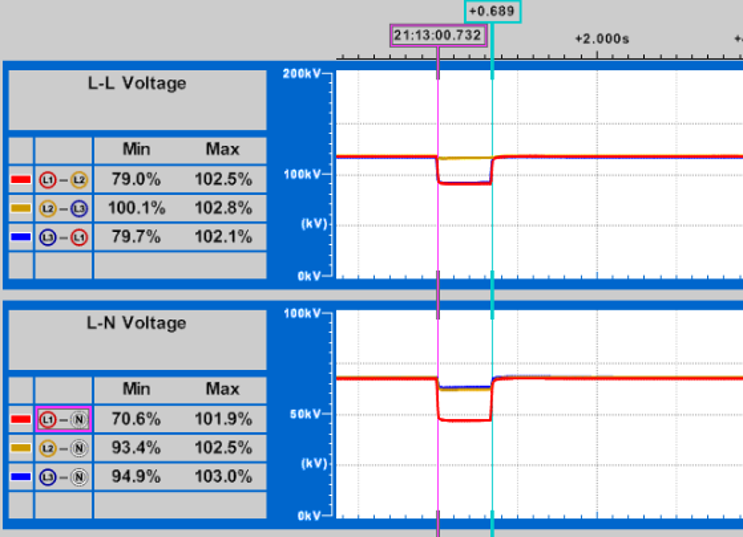Decoding Voltage Sag/Dip Graphs📊
- Truewatts
- Jul 22
- 3 min read
Updated: Jul 23
Understand voltage sag graphs with ease—gain insights to analyze, plan, and make better decisions
At Truewatts, we’ve had the opportunity to support many clients in analyzing data from Power Quality Meters (PQ Meters), especially when dealing with voltage sags or dips.And quite often, the questions that follow are:
👉 “What exactly does this graph mean?”
👉 “How can we make practical use of this data?”
This article walks you through how to interpret Voltage Sag/Dip graphs effectively—along with how these insights can drive technical decisions and planning with real impact.
🧩 What’s the difference between a Voltage Sag and a Voltage Dip?
While the terms Voltage Sag and Voltage Dip are used differently depending on region and standards, they refer to the same event:a temporary drop in voltage in an electrical system.
Here’s how they differ in usage:
✅ Voltage Sag: Commonly used in North America (IEEE, EPRI, etc.)
✅ Voltage Dip: Used in Europe and in international standards (e.g., IEC)
According to IEEE 1159, a voltage sag is defined as:
"A decrease to between 0.1 and 0.9 per unit in RMS voltage or current at the power frequency, for durations of 0.5 cycle to 1 minute."
📉 Sample Graph from a PQ Meter
The graph below is captured from MDB (Main Distribution Board) using a Power Quality Meter.


It clearly shows a voltage drop (Voltage Sag/Dip).
🔍 Data at a glance:
Voltage dropped to 70.62% of nominal
Duration: 0.689 seconds
Timestamp of the event recorded
🧠 Why Do Magnitude and Duration Matter?
To evaluate the impact of a Voltage Sag, two key parameters must be considered:
🔹 Magnitude – The depth of voltage reduction compared to the nominal voltage, expressed as a percentage of the nominal voltage.
For example: 70%, 50% of nominal
If the voltage dips below a device’s tolerance level, it may trip or reset.
PLCs typically withstand only 80–90%; inverters around 70–80%.
🔹 Duration – How long the sag lasts
Example: 0.1 sec vs. 0.7 sec
sags (20–40 ms) might be tolerable for some equipment
Sags lasting over 100–200 ms significantly increase trip risks
💡 In this case, a sag to 70% lasting 0.689 seconds is both deep and long—well beyond the tolerance of most industrial equipment.
📌 This data can be compared to standards like:
SEMI F47
IEC 61000-4-11
To determine if protective equipment or design changes are needed.
🎯 How Can You Use This Data?
1️⃣ Identify Root Causes of Equipment Shutdown
If a PLC reset, inverter tripped, or production line stop at the same timestamp →You can confirm Voltage Sag was the root cause
✅ Saves time chasing mechanical or software issues
2️⃣ Support Investment Decisions for Protection Equipment
For example:
Voltage Compensation System
UPS for Control Circuits
✅ In this case, a 0.7-second sag exceeds tolerance of most PLCs (20–100 ms)→ Justifies installing sag-mitigation solutions in key areas
3️⃣ Use as Technical Evidence
If damages or downtime occur:
Include this graph in reports to utilities or equipment manufacturers
Reference sag immunity specs (e.g., SEMI F47, IEC 61000-4-11)
4️⃣ Compare with Sag Tolerance Standards
Use:
Voltage: 70.62%
Duration: 0.689 sec
Compare against:
CBEMA / ITIC Curve
SEMI F47
IEC 61000-4-11 test levels
✅ If the equipment should’ve tolerated the sag but still tripped→ Review circuit design (especially control circuits)
5️⃣ Plan Power System Improvements
Install permanent PQ meters or adjust measurement locations
Separate critical vs. non-critical loads
Assess feasibility of Fast Transfer Switches or ATS systems
💬 Need Help Decoding Your PQ Data?
If your is looking to get the most value out of PQ event data—or is considering equipment to improve voltage sag — We are here to help. Info@truewatts.co.th




Comments